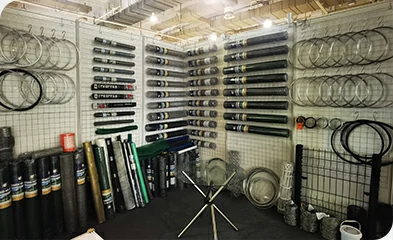 TEL:
+86-13102802206
TEL:
+86-13102802206
 Email:
fencenetting@china.com
Email:
fencenetting@china.com
 Language
Language
 TEL:
+86-13102802206
TEL:
+86-13102802206
 Email:
fencenetting@china.com
Email:
fencenetting@china.com
 Language
Language


The Significance of Barbed Wire on Top of Walls
Barbed wire, often seen coiling atop fences and walls, serves as a stark symbol of security, control, and separation. Its sharp edges and formidable appearance evoke a sense of danger, making it a common sight at military installations, prisons, and private properties requiring heightened security measures. This article explores the historical origins of barbed wire, its multifaceted uses, and the societal implications of its presence on structures.
Historical Origins
The invention of barbed wire dates back to the late 19th century. It was primarily developed as a solution for fencing in the expansive American West, where traditional wooden fences were impractical and costly. Joseph Glidden, an Illinois farmer, patented his version of barbed wire in 1874, which rapidly gained popularity. The effectiveness of barbed wire in marking property lines and containing livestock revolutionized agriculture and contributed to the westward expansion of the United States.
However, the utility of barbed wire soon transcended agriculture. During World War I, it was extensively used in military fortifications to protect trenches and impede enemy advancement. The sharp barbs made it an effective deterrent, ensuring that any attempt to breach defenses came with significant risk. Today, its military applications have evolved, but barbed wire still plays a critical role in security and containment methods worldwide.
Multifaceted Uses
Barbed wire is deployed for various purposes beyond its initial agricultural intent. In contemporary society, it marks the boundaries of prisons, securing inmates and deterring escapees. The sight of barbed wire on prison walls has become synonymous with confinement and punishment, highlighting the stark realities of the criminal justice system. Its presence emphasizes a society’s stance on crime and punishment, often prompting discussions about rehabilitation versus retribution.

In addition to correctional facilities, barbed wire is widely employed in military contexts. It secures operational bases and keeps unauthorized personnel at bay. In conflict zones, it is used as a tool for demarcating safe areas, such as refugee camps or zones intended for humanitarian aid. The implementation of barbed wire in these landscapes raises ethical questions about the treatment of displaced individuals and the accessibility of aid, often reflecting broader geopolitical issues.
Furthermore, barbed wire has become a prominent symbol in discussions surrounding immigration and border control. Countries frequently employ it to reinforce borders and prevent illegal crossings. The sight of barbed wire along national boundaries can provoke feelings of fear, vigilance, and sometimes hostility. Critics argue that such barriers reflect an increasingly militarized approach to immigration, underscoring a divide between people and nations. The use of barbed wire in these contexts illuminates the intersection of security and human rights, inviting ongoing debates about the ethical ramifications of such physical barriers.
Societal Implications
The presence of barbed wire atop walls serves as a powerful visual metaphor for societal divisions. It represents not only physical barriers but also ideological ones—symbolizing fear, distrust, and the desire for control. As communities grapple with issues such as crime, immigration, and national security, the implementation of barbed wire often mirrors collective sentiments of anxiety and defensiveness.
However, the psychological impact of barbed wire extends beyond its physical deterrent capabilities. Its starkly aggressive appearance can foster a climate of fear and tension, making spaces feel less welcoming and more hostile. In residential neighborhoods, the installation of barbed wire can indicate a breakdown in community trust, reinforcing the belief that danger is always lurking just beyond one’s property line.
In conclusion, barbed wire on top of walls encompasses a myriad of meanings and uses across various contexts. While it serves practical functions in enhancing security, it also raises significant concerns about social implications, ethics, and the human experience. As societies continue to navigate the complexities of safety and freedom, the presence of barbed wire will undoubtedly remain a potent symbol of our struggles with trust, separation, and the quest for security. It is essential that we contemplate the messages these formidable barriers convey and strive toward creating environments that prioritize community and cooperation over confinement and distrust.